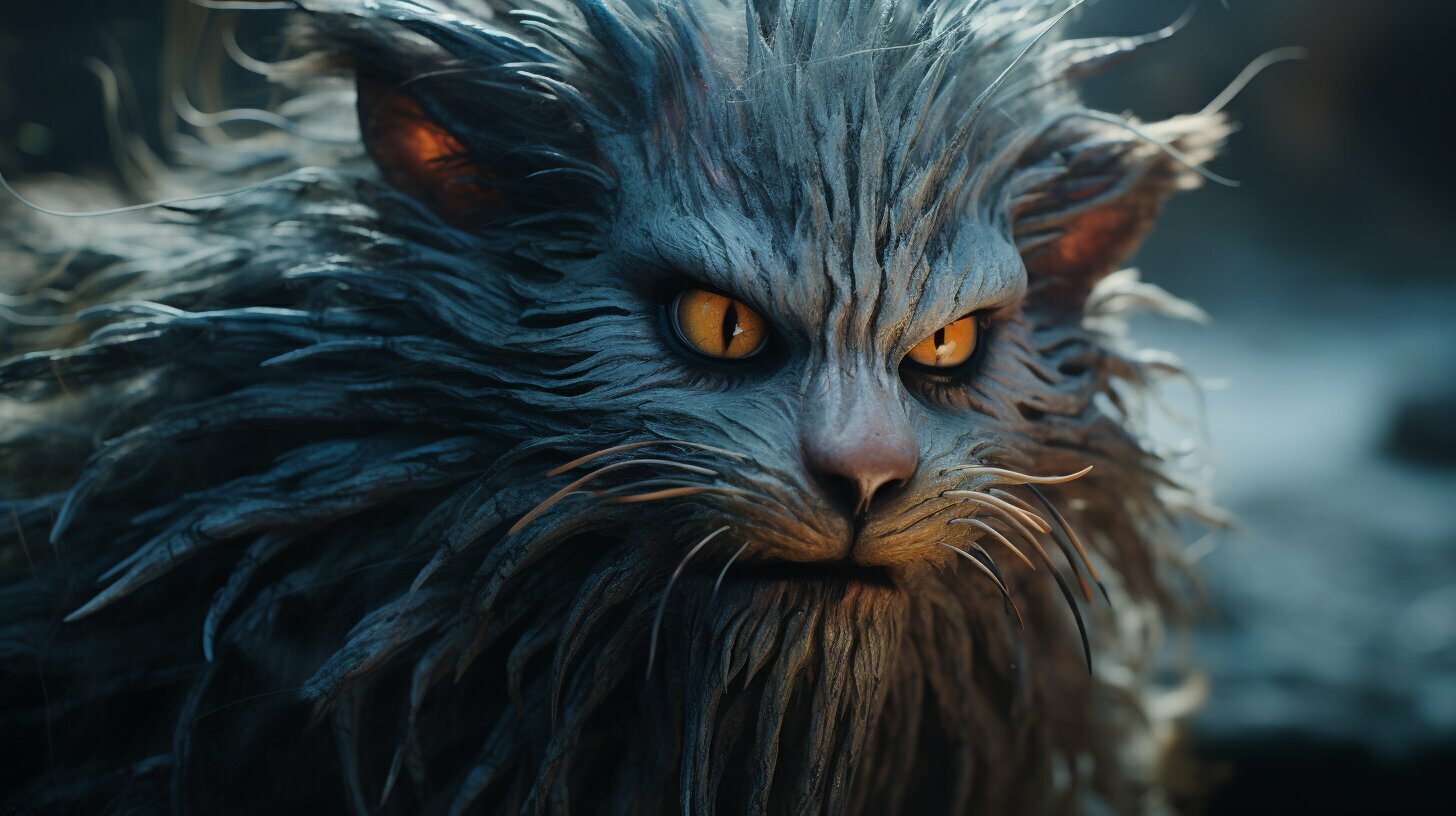Discover the Fascinating World of Hairy Animals with Me
Welcome to my captivating journey into the realm of hairy animals, where we will uncover the wonders of fur-covered creatures and the marvels of mammalian hair. Prepare to be amazed as we explore the diverse habitats, unique characteristics, and incredible behaviors of these remarkable beings.
Key Takeaways:
- Wombats are marsupials found in Australia, known for their fuzzy appearance and burrowing abilities.
- There are three species of wombats – the common wombat, the Southern hairy-nosed wombat, and the Northern hairy-nosed wombat.
- Wombats have wide, strong feet for digging and feed mainly on native grasses.
- They can reach surprising speeds and shape their droppings into angular cubes to mark their territory.
- The Northern hairy-nosed wombat is critically endangered, with efforts being made to conserve and increase their population.
The Incredible Wombats – Australia’s Fuzzy Burrowers
Let’s begin our exploration with the incredible wombats, fascinating hairy mammals that call Australia their home. Wombats are marsupials, like koalas and kangaroos, and their babies are known as joeys. There are three species of wombats – the common wombat, the Southern hairy-nosed wombat, and the Northern hairy-nosed wombat. They live in various habitats in Australia, including mountains, forests, and grasslands.
Adult wombats can grow up to a meter long and weigh up to 40 kilograms. They have wide, strong feet that are great for digging. Wombats spend their nights foraging for food and digging burrows. They are herbivores and mainly feed on native grasses. Wombats can surprisingly reach high speeds for up to 90 seconds.
Fun fact: Wombats shape their poop into angular cubes and use it to mark their territory.
Wombat burrows, known as warrens, can be massive and can serve as shelters for other small mammals during bushfires. Wombats have backward-facing pouches, which protect their joeys from dirt while they dig. Unfortunately, the Northern hairy-nosed wombats are critically endangered, with only 115 left on Earth. However, efforts are being made to conserve and increase their population.
| Species | Habitat | Size |
|---|---|---|
| Common Wombat | Forests and grasslands | Up to 40 kilograms |
| Southern Hairy-nosed Wombat | Grasslands | Up to 35 kilograms |
| Northern Hairy-nosed Wombat | Grasslands | Up to 40 kilograms |
The Importance of Wombat Conservation
Wombats play a vital role in maintaining the balance of Australia’s ecosystems. By digging burrows, they create habitats for various species, including reptiles and small mammals, during extreme weather conditions. Additionally, their feeding habits contribute to seed dispersal, aiding in the regeneration of native grasses.
- Wombats are excellent burrowers and create underground tunnels for protection.
- They have a highly efficient digestive system and can extract maximum nutrients from their vegetarian diet.
- Wombats are known for their resilience and adaptability to the harsh Australian environment.
Conservation efforts are crucial to ensuring the survival of wombats, especially the critically endangered Northern hairy-nosed wombat. Through habitat protection, captive breeding programs, and community awareness, we can help secure the future of these incredible, fuzzy burrowers.
Join me in the next section as we explore the diversity of hairy primates around the globe.
The Diversity of Hairy Primates Around the Globe
Join me as we uncover the captivating lives of hairy primates, wild animals with fur that populate different parts of the world. From the jungles of Africa to the lush rainforests of Southeast Asia, these fascinating creatures display remarkable adaptations and behaviors that have intrigued scientists and nature enthusiasts for centuries.
One such primate is the critically endangered Sumatran orangutan. With their long, reddish-brown hair and distinctive cheekpads, these magnificent apes are found only on the island of Sumatra in Indonesia. Known for their high intelligence and gentle nature, orangutans spend most of their lives in the trees, using their strong arms and flexible fingers to navigate their arboreal habitats. They primarily feed on fruits, leaves, bark, and occasionally insects, and their complex social structure adds to the intrigue of studying these remarkable creatures.
Another remarkable primate is the gelada baboon, also known as the bleeding-heart monkey. These unique primates, found in the highlands of Ethiopia, have dense fur covering their bodies, providing insulation against the chilly temperatures. But what sets them apart is their vibrant facial coloring during social interactions, when the males display bright red patches on their chests and necks. Gelada baboons live in large social groups called “units” and spend their days grazing on grasses and socializing through intricate vocalizations and grooming rituals.
Hairy Primates of Africa
| Primate | Habitat | Notable Features |
|---|---|---|
| Sumatran Orangutan | Sumatra, Indonesia | Long reddish-brown hair, distinctive cheekpads |
| Gelada Baboon | Highlands of Ethiopia | Dense fur, vibrant facial coloring during social interactions |
These are just a glimpse into the rich diversity of hairy primates that inhabit our planet. From the acrobatic gibbons swinging through the canopies of Southeast Asia to the majestic gorillas roaming the forests of Central Africa, each species has its own story to tell. By studying and protecting these wild animals with fur, we not only gain insights into their complex lives but also contribute to the preservation of our fragile ecosystems. So let’s continue our journey and marvel at the wonders of the hairy primate world!
Majestic Hairy Mammals of the Arctic and Subarctic Regions
Brace yourself for an awe-inspiring journey into the frigid landscapes inhabited by majestic hairy mammals, showcasing their remarkable ability to thrive in extreme environments.
The Arctic and Subarctic regions are home to a diverse range of hairy animals that have adapted to survive in the harsh cold. One such example is the polar bear, the largest land carnivore on Earth. With their thick, insulating fur and layer of blubber, polar bears are perfectly equipped to withstand the freezing temperatures of the Arctic. These powerful predators spend much of their time hunting for seals on the sea ice.
Another fascinating hairy mammal found in this region is the musk ox. These shaggy creatures have a double-layered coat consisting of a coarse outer layer and a soft, woolly underlayer called qiviut. Qiviut is incredibly warm and highly prized for its softness, making it a valuable material for crafting. Musk oxen live in herds and use their large, curved horns to defend themselves from predators.
Let’s not forget about the Arctic fox, a small but resilient mammal that possesses a dense coat of fur to protect against the freezing temperatures. These resourceful creatures change their fur color with the seasons, adapting from white in winter to brown or gray in summer, providing excellent camouflage in their snowy surroundings.
| Mammal | Description |
|---|---|
| Polar Bear | The largest land carnivore on Earth, with thick fur and a layer of blubber for insulation. |
| Musk Ox | Shaggy herbivores with a double-layered coat of qiviut, a soft, woolly underlayer. |
| Arctic Fox | Small, adaptable mammals with fur that changes color with the seasons for camouflage. |
These majestic hairy mammals have carved out their existence in the extreme conditions of the Arctic and Subarctic regions, demonstrating the incredible adaptability and resilience of nature. Their unique adaptations, from thick fur to camouflage, allow them to thrive in environments that would challenge most other animals.
Surprising Facts About Hairy Creatures Under the Sea
Prepare to be amazed by the incredible diversity of hairy animals that inhabit the ocean depths, showcasing their adaptations to the underwater realm. From vibrant corals to enigmatic sea anemones, the underwater world is teeming with fascinating creatures that sport an array of hairy features.
One such creature is the hairy frogfish, a master of disguise that can change its color and texture to blend in seamlessly with its surroundings. With its hairy exterior and a mouth that can expand to engulf prey larger than its own size, the hairy frogfish is a true marvel of evolution.
Another remarkable example is the hairy starfish, also known as the “Crown of Thorns.” This majestic creature boasts a crown-like appearance with long, hairy spines covering its body. While these hairy spines may seem intimidating, they actually serve as a defense mechanism, deterring potential predators.
And let’s not forget about the hairy crab, a small yet fascinating creature found in the depths of the ocean. With its dense covering of hair-like bristles, the hairy crab not only looks adorable but also uses its hairy limbs to filter tiny particles and capture its food.
| Hairy Creatures Under the Sea | Fun Fact |
|---|---|
| Hairy Frogfish | Can change color and texture to blend in with surroundings |
| Hairy Starfish | Uses hairy spines as a defense mechanism |
| Hairy Crab | Filters tiny particles with its hairy limbs |
These are just a few examples of the astonishing diversity of hairy creatures that call the ocean their home. Each species has its own unique adaptations and behaviors, making the underwater world a fascinating and mysterious place to explore. So next time you dive into the depths, keep an eye out for these hairy wonders and marvel at the wonders of the underwater realm.
Conclusion
As we conclude our exhilarating expedition through the realm of hairy animals, we are left in awe of the astounding diversity and importance of these fur-covered creatures. From the incredible wombats of Australia, with their fuzzy burrows and unique behaviors, to the diverse range of primates that boast impressive coats of hair, to the majestic mammals of the Arctic and Subarctic regions with their remarkable adaptations, and even the surprising hairy creatures that dwell beneath the sea, the world of hairy animals is truly captivating.
Wombats, those adorable marsupials, inhabit various habitats in Australia and display fascinating traits. With their strong feet and exceptional digging abilities, wombats create extensive burrows that provide both shelter and safety to other small mammals during bushfires. It’s unfortunate to learn that the Northern hairy-nosed wombats are critically endangered, but ongoing conservation efforts give hope for their future.
Throughout our journey, we discovered remarkable facts about these extraordinary creatures. Wombats, herbivores by nature, feed on native grasses and exhibit surprising speed for short bursts. Their distinctive cubed-shaped feces not only serves as a territorial marker but also showcases their unique digestive system.
With the incredible variety and significance of hairy animals in our ecosystem, it is evident that they play a crucial role in maintaining the balance of nature. By constantly adapting to their environments and demonstrating remarkable survival strategies, these fur-covered creatures serve as a reminder of the wonders and marvels that exist within the natural world.
FAQ
What are the three species of wombats?
The three species of wombats are the common wombat, the Southern hairy-nosed wombat, and the Northern hairy-nosed wombat.
Where do wombats live?
Wombats live in various habitats in Australia, including mountains, forests, and grasslands.
How big can adult wombats grow?
Adult wombats can grow up to a meter long and weigh up to 40 kilograms.
What do wombats feed on?
Wombats are herbivores and mainly feed on native grasses.
How fast can wombats run?
Wombats can surprisingly reach high speeds for up to 90 seconds.
What do wombats use to mark their territory?
Wombats shape their poop into angular cubes and use it to mark their territory.
How many Northern hairy-nosed wombats are left on Earth?
Unfortunately, there are only 115 Northern hairy-nosed wombats left, making them critically endangered.
What efforts are being made to conserve the Northern hairy-nosed wombats?
Efforts are being made to conserve and increase the population of the Northern hairy-nosed wombats.






